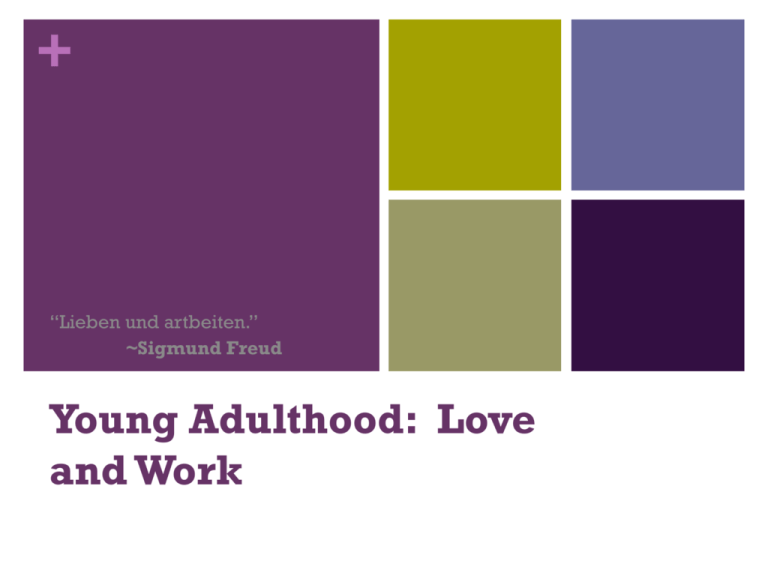
+
“Lieben und artbeiten.”
~Sigmund Freud
Young Adulthood: Love
and Work
+
Transition to Adulthood
Accepting responsibility for oneself
Making independent decisions
Becoming financially independent
Intimacy versus isolation is central conflict according to
Erikson
Cultural variations include:
Israeli’s completing military service
Korean support parents financially
Traditional cultures focus on marriage
+
Sternberg’s Triangular Theory
of Love
+
Changes in Love
The three components follow a predictable trajectory
+
Marriage
Marriage may exist for several reasons:
Uniting people to serve complementary gender roles
Reduces sexual competition
Necessary for the species
Variation between cultures in choice of marriage
partners, economics and number of marriage partners
+
+
Arranged Marriages
Romantic love may not be a basis for marriage for all
cultures
Arranged marriages are an alliance between families
with love developing after marriage
Commitment first and attachment second
Marriage is also seen as an economic institution
Many traditional cultures are shifting from “arranged”
to semi arranged
+
Western Marital Roles
Western view of marriage strongly based on intimacy
and sexual relationships
Focus on ideal mate could lead to marital
dissatisfaction
Belief in self-fulfillment in marriage leads to high
divorce rate in the U.S.
+
Figure 10.3 Divorce Peaks in
Young Adulthood
+
Divorce
Causes of divorce include
Age at marriage—younger than 25
Divorced parents
Socioeconomic status—conflict and stress over finances
Partner behavior—drinking or drug use, infidelity
Adjustments after divorce hardest in first 1–2 years
+
Single Adults
Compared to married young adults it was thought
being single led to
Increased mental health problems
Physical health problems
Substance abuse
Thorough analysis has shown all these negative effects
were overblown
Ethnic variations exist in singlehood
African Americans have higher rates of cohabitation than
other groups
In Asian countries (urban) 1/3 of woman 30-34 are single
In Japan, single young adults are the happiest group
+
Gay and Lesbian Partnerships
There are similarities between homosexual and
heterosexual partnerships
Seek long term relationship
Seek out similar partners and have similar areas of conflict
Differences include
Gay couples tolerate sexual episodes more than lesbian or
heterosexual couples
Higher sexual activity
Many differences are fading as acceptance increases
+
Becoming a Parent
Traditional countries
Becoming a parent is extremely important
Fertility is goal of a woman and men enjoy greater status
Developed countries
Parenting is a choice and may not be extremely important
Parents more likely to be on their own although there are
ethnic group differences
Single motherhood is higher now than 50 years ago
In U.S. there are ethnic and education differences
+
The Meaning of Work
Most people work to make a living but also find meaning in
their work
Research has found that people have four common ways in
which personal fulfillment is derived from work
Developing and becoming self
Union with others to pursue a common purpose
Expressing self
Serving others
+
Choosing an Occupation
Holland’s Theory of Occupational Choice
People pursue careers that are a good fit between their
abilities and interests
Six personality types that combine these factors:
investigative, social, realistic, artistic, conventional, and
enterprising
Holland’s theory does not tell us much about the
differences among ethnic groups or other cultural groups
+
Super’s Theory
People progress along a continuum of vocational maturity
through five stages
Implementation stage
Establishment stage
Maintenance stage
Deceleration stage
Retirement stage
Occupational aspirations at age 16 in the U.K. predicted
occupational attainments at 33
In the U.S., people change occupations several times
during adulthood
+
Occupational Development
How we advance within chosen occupations depends on
many factors including
Expectations
Support from coworkers
Priorities
Job satisfaction
+
Occupational Expectations
Changing interests and failure can be cause for changing
the dream
Leaving school and learning about the real world is often a
time of reality shock for young adults
Job satisfaction tends to increase with age
Probably because with advancing age, workers tend to select
and stay with jobs that satisfy them and move on from work that
is less satisfying
+
The Role of Mentors and Coaches
More experienced workers often communicate the most
critical kinds of information rather than formal training
Mentors help young workers avoid trouble and explain the
unwritten rules of the job
Mentors often guide young workers and help to ensure that
they are noticed and get credit from supervisors
+
The Role of Mentors
(Cont)
Kram described four phases of the mentoring relationship:
Initiation
Cultivation
Separation
Redefinition
+
Work-Family Conflict
Dual-earner couples have difficulty finding time for each other
The amount of time is not necessarily the most important issue
as long as they enjoy the time together and it is spent in shared
activities
Many mothers have to return to work after the birth of a baby
Some women struggle with the issue of returning to work, weighing
financial need and the need to care for their children
Some women feel the need to return to work as a result of
attachment to their work
Giving up work means a redefinition of one’s identity
Highest level of stress was during the peak parenting years
when there were often at least two preschool children in the
home
+
Division of Household Labor
Women spend up to 50% more hours per week than men in
family work
Unequal division of labor is the greatest source of
arguments and unhappiness in two-earner households
While men have increased the amount of time spent on
household chores, the greatest amount of the increase is on
the weekends
+
Division of Household Labor
The division of household labor is often the result of
people’s experience with their parents’ assignment of
chores
Men are more satisfied with the division of household labor
Women are not as concerned about the amount of time men
spend on household chores as when there are certain
“women’s chores” that men will not perform
Even when women enjoy doing tasks that are traditionally
considered “women’s work,” they may still experience role
strain when a partner does not also engage in these tasks
+
Support in the Home
Women are more satisfied when men take on tasks that are
traditionally women’s chores
African American and Hispanic men spend more time on
household chores than European American men







